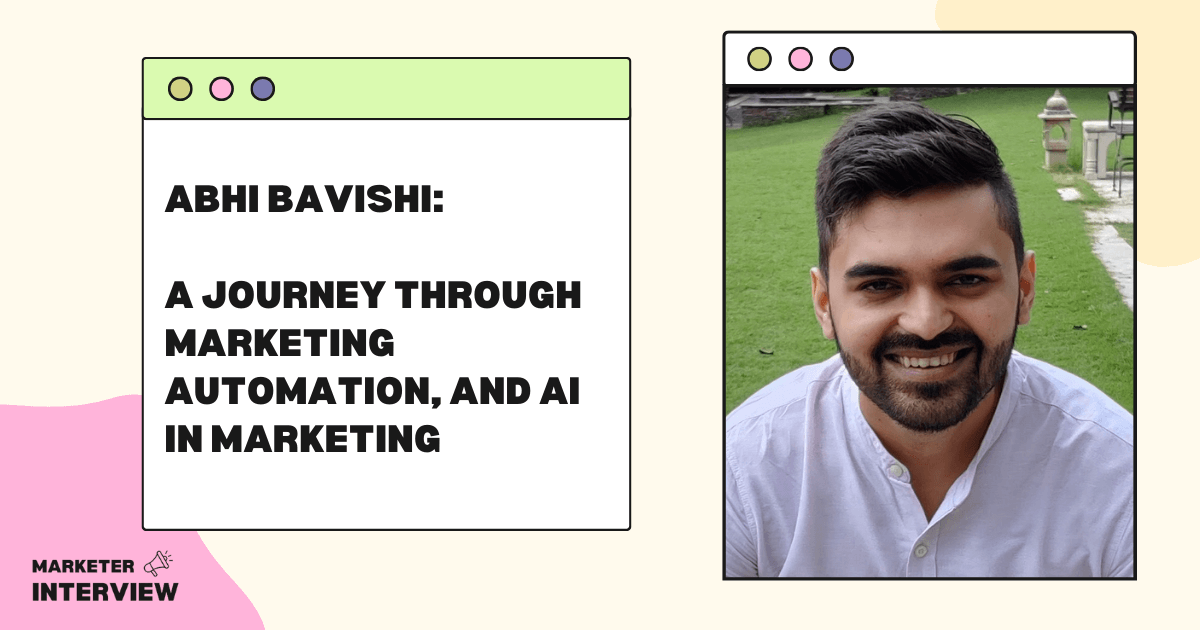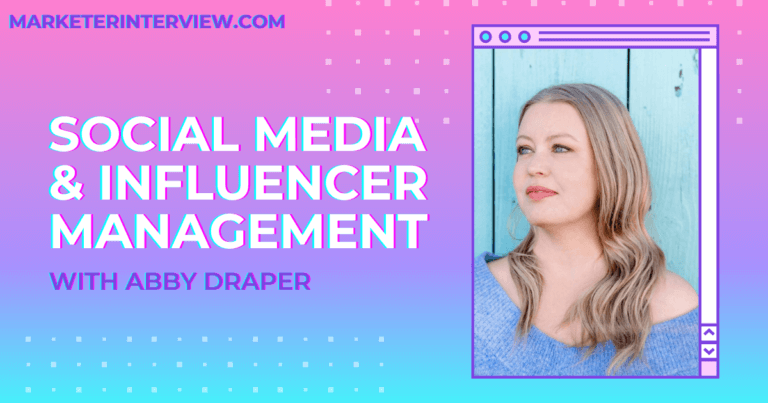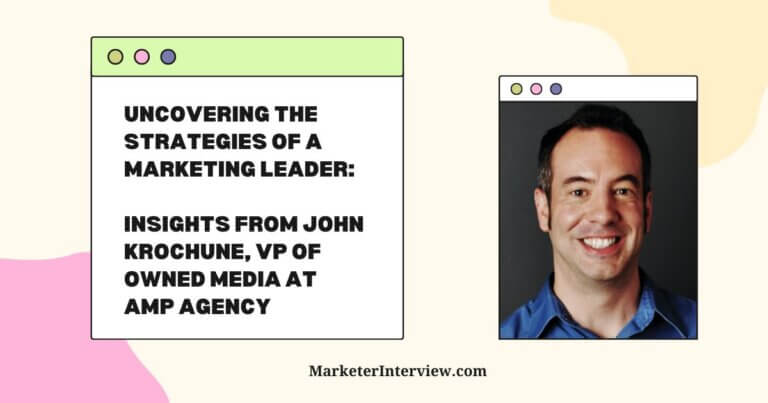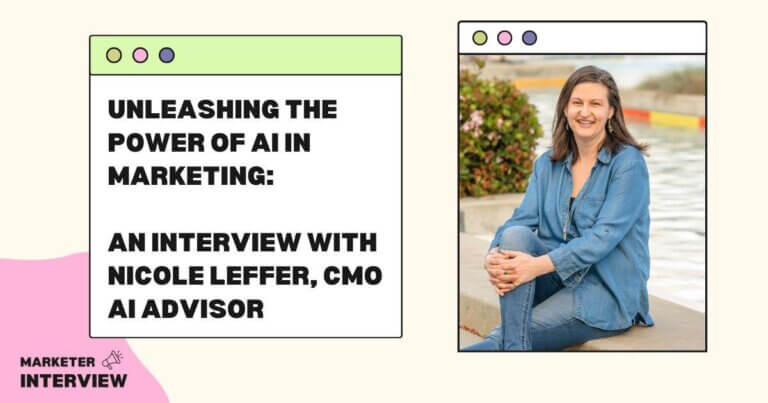Abhi Bavishi: A Journey through Marketing Automation, and AI in Marketing
Today, we have the pleasure of interviewing Abhi Bavishi, a versatile growth marketer with over 11 years of experience in the field.
He has worked with startups, SMBs, and Fortune 500 companies, developing his skills in marketing automation, CRO, marketing analytics, and AI in marketing.
Abhi is also the founder of India’s #1 ranked smart home store, Smartify.
In this interview, we’ll delve into Abhi’s career journey and get insights into his expertise. Let’s dive in!
Contents
- 1 Can you tell us about your background and how you got into marketing?
- 2 You have a broad range of experience across different marketing functions, can you describe how you develop expertise in multiple areas?
- 3 What is your approach to developing and executing successful marketing campaigns?
- 4 Could you walk us through a recent marketing campaign you led and its results?
- 5 How do you use marketing automation to improve customer engagement and conversion rates?
- 6 What are some of the most common challenges you face when implementing marketing automation, and how do you address them?
- 7 Can you tell us about a successful CRO project you’ve led and the impact it had on the business?
- 8 How do you use marketing analytics to measure the success of your campaigns and make data-driven decisions?
- 9 How do you see AI transforming marketing in the coming years, and what are some ways businesses can prepare for this change?
- 10 Could you share with us the tools and software you use in your work as a growth marketer, and how they help you achieve your goals?
Can you tell us about your background and how you got into marketing?
I come from a Computer Science background, and we were never taught marketing in school or college, so how I stumbled into marketing, and eventually decided to pursue it full-time, is a pretty long story.
During college, I was fascinated by computers, and I had an unique ability of understanding highly complex technical concepts, and explaining them in simple language.
I decided to montise this ability during my college time by signing up as a tech writer on a popular freelancing website. I was able to make around $500-$1000/month on the side, working for tech blogs, SaaS startups, etc.
However, after college, I decided to pursue my career as a software developer, because I wanted to work in a corporate environment, and deliver work that will have real-world impact.
But, within just 15 months, I decided to quit the company.
The reason?
That’s because I realised that even though I loved coding, I didn’t like the fact that I had to be dependent on a company to pay the bills.
I realised that if I wanted to be truly free in life, I had to figure out a way to monetise my skills, without getting handcuffed.
So, I started freelancing again as a content writer. I worked without about 10+ companies in a short span of 6 months, helping them with website content, blogs, eBooks, and more.
However, I quickly realised that even though I loved writing content, I was also a great developer, and I wanted to find a way to merge these diverse skills.
The turning point came when I was asked to write website content for a popular SaaS startup, and I had to deep-dive into behavorial psychology to create content that would not just provide information to the visitors, but also turn them into paying customers.
So, in learning more about copywriting, I started deep-diving into core marketing concepts, and started applying them in my startup, Smartify, to gain hands-on experience.
The result was that I was able to take my side-project to the first page of Google using just SEO techniques on a $0 marketing budget. The website generates about $100K+ worth of leads/month, and requires almost no paid marketing.
But, anyway, back to your question…
The decision to shift from development to marketing wasn’t easy, but it was worth it.
Every campaign, every strategy I crafted and saw working in real-time was a thrill. It was akin to the satisfaction of seeing a complex piece of code run flawlessly.
I realized that at the core of both coding and marketing is a problem-solving ethos – whether it’s addressing a software glitch or improving customer engagement.
In retrospect, my journey from a tech content writer to an entrepreneur, and then to a growth marketer, was not straightforward.
But it was this unconventional route that equipped me with a broad perspective, allowing me to bring a blend of technology and creativity to my marketing approach.
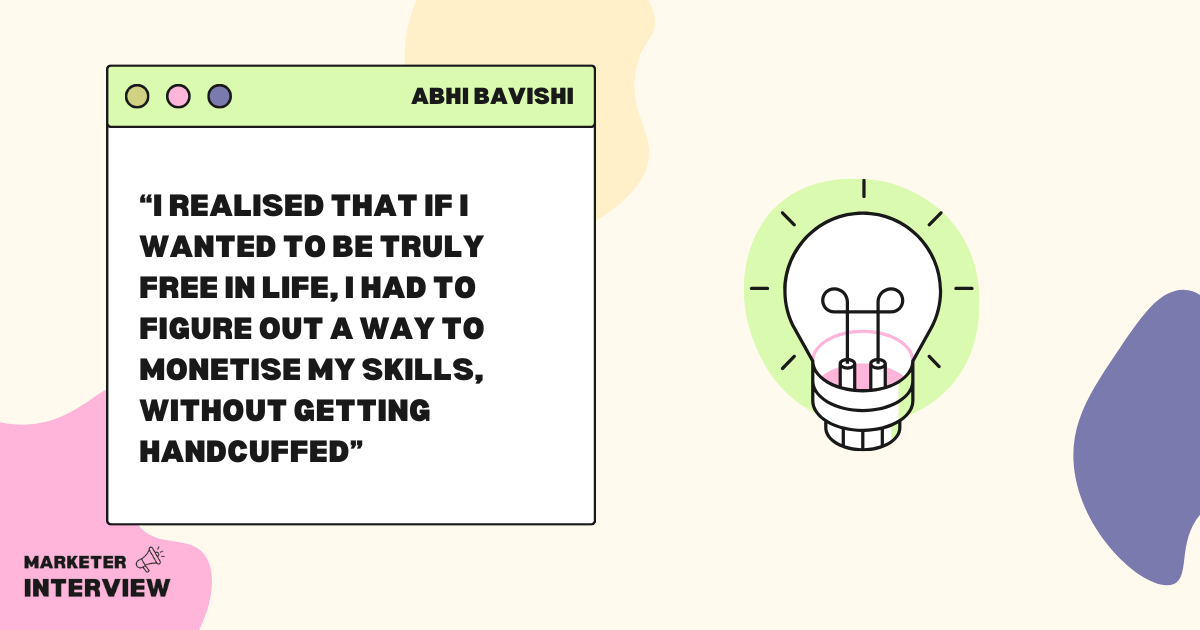
You have a broad range of experience across different marketing functions, can you describe how you develop expertise in multiple areas?
Yes, I like to call myself a “M-shaped” marketer, instead of the traditional “T”.

That’s because I have deep-knowledge in various areas of marketing and tech, and I’m able to leverage the diverse knowledge to come-up with unique ways to solve marketing challenges.
Just to give you some context, I’m able to:
- Write backend code and scripts using Python/Javascript
- Build complex automations using tools like make.com/zapier
- Build custom marketing tools using tools like Glide or Airtable
- Create a marketing strategy using Miro or Figma
- Design and develop a website using Webflow or Framer
- Run cold email campaigns using lemlist or Phantombuster
- Create explainer videos using tools like Camtasia
… and the list goes on.
For a lot of the startups that I work with, I’m the sole person that manages their marketing initiatives, automation workflows, content strategy, SEO, AI chatbot integrations, etc.
Now, to learn these skills, you don’t need to have a background.
All you need to have is a “growth mindset”.
A growth mindset is when you believe that you can learn anything that’s required of you to do your job. A fixed mindset is when you believe that “this is not your job”.
The easiest way to learn a new skill is to allocate a certain amount of time to it every week, and use it to solve a real-life problem.
For example, when ChatGPT API rolled out a few months back, I knew nothing about building AI bots, but I wanted to solve a core problem for a business, which was to reduce the amount of time it took them to get back to their customers.
So, I built a bot in Python that would read the contents on their entire website based on their sitemap, and answer any question that has already been answered in real-time. We were able to integrate the bot with popular messaging platforms like Intercom, and reduce the amount of time it took to answer pre-sales or support questions.
Again, I learnt a new skill in this process (building conversational chatbots using AI) by just having a growth mindset, and focusing on building the MVP as soon as possible, so that it could solve a real-world problem.
Most people are not able to learn the skills they need, because they are either too afraid to try, or get too stuck in perfecting the skill.
Instead, if you focus on solving a real-world problem, and have a ‘test-and-measure’ mindset, you’d be surprised by how much you can accomplish in a short amount of time.
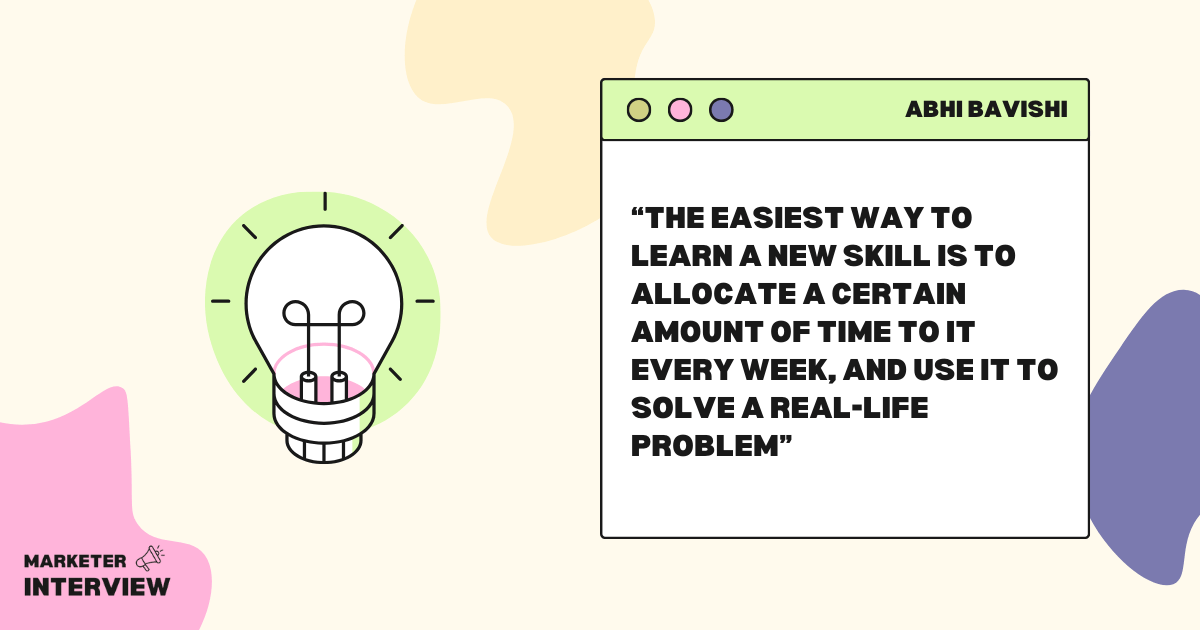
What is your approach to developing and executing successful marketing campaigns?
My approach to developing and executing marketing campaigns is dead simple:
- Understand the Audience: You can’t create an impactful campaign without knowing your audience inside out. I invest significant time in understanding the target audience’s demographics, psychographics, and buying behavior.
- Align the messaging: A great campaign aligns perfectly with the business goals. So, I try to align the value propositions of the product/service with the audience’s expectations, so that they can clearly see how “what we offer” solves their problem, and delivers them the transformation they need.
- Keep experimenting: Marketing is not a one-shot game. You might have to try out various different ideas, before you finally come across a campaign idea that really works. So, it’s extremely important to setup an analytics stack, and monitor the qualitative and quantitative aspects of the user journey.
Could you walk us through a recent marketing campaign you led and its results?
Yes, so, I recently created an outreach campaign for a technology startup, where we used Generative AI’s capabilities to create a cold outreach campaign.
Here’s what I did:
- I created an ICP profile with the client, and then used Apollo.io to find these prospects, and extracted their emails in a spreadsheet.
- Next, I wrote a custom appscript function that would go to their website, extract the entire content, pass it to gpt-3.5 model, and asked it to summarise the content in a specific format, so that I can generate a personalised ice-breaker and assign a more accurate category to the website (for example: real estate agent v/s real estate)
- Once this was setup, I used a tool, called Hyperise to personalise this information in a visual format (GIFs), and then leveraged GPT4’s capabilities to come-up with an engaging cold email copy for the sequence.
I was able to build the whole campaign in less than a week, and in terms of performance, we had close to 12% reply-rate, and we were able to generate almost $50K+ worth of leads with a $500 marketing budget (only tool-cost included).
How do you use marketing automation to improve customer engagement and conversion rates?
Marketing automation is a game-changer when it comes to scaling engagement and conversions. At a high-level, here’s how I use marketing automation:
- Collect data-points about the customer: If you want to make the best out of any marketing automation tool, you need to collect as many data-points about them as possible, so that you can group them into segments and personalise their journeys.
For instance: I like to use Apollo.io to enrich all possible data-points about the B2B customer (i.e industry, revenue, job title, country, funding, company size, etc), so that we can put the prospect/company in the correct segment, and personalise their journeys based on the problems they face. - Track customer activities: You can use marketing automation tools like Intercom, ActiveCampaign, Hubspot, etc to track customer activities (visited a page, clicked on a link, etc), and then use that trigger information to setup different targeted campaigns.
One of my favourite examples of one such campaign is to proactively nudge a new customer to book an onboarding call, if they haven’t done the primary action inside the tool (activation checkpoint), even after 7-days of purchasing the tool. - Build personalised customer journeys: Once you’ve setup the above (enrichment + user activity tracking), you can then move to create personalsied customer journeys using marketing automation tools.
Since I work with SaaS startups, most campaigns are split into three categories:
Boost activation: These campaigns are focused on educating a new user about the tool, and taking them to a point where they unlock the value proposition of the software/tool.
For example: If the app is Dropbox, the activation could be sharing the first folder link with someone.
Now, you can use marketing automation tool to boost activation in a completely automated way.
Here’s an example of an activation campaign that builds on top of enrichment + customer activity tracking to build personalised customer journeys:
- User signed up -> Check if they belong to startup segment with 50+ employees
- Wait for 3 days -> Check if they explored Feature A, Feature B, Feature C
- If not explored -> nudge them to explore each feature with email + product tour (Intercom)
- All three features explored? -> Nudge them to become premium.
Increase retention: With these campaigns, the primary goal is to ensure that users find sustained value in the tool or platform. One approach I adopt is the timely introduction of advanced features or use-cases that a customer might not have explored yet. By consistently introducing them to new ways they can derive value from the platform, their reliance and trust in the solution grow.
For instance, if using a SaaS tool like Slack, a retention campaign might look like this:
- User has been active for a month
- Survey their primary use cases and satisfaction levels
- Introduce them to a new feature or integration that aligns with their business needs
- Offer a webinar or tutorial on best practices or advanced functionalities
- Check-in at regular intervals to solicit feedback and ensure they’re deriving maximum value
- Provide incentives or loyalty rewards for continuous usage and referrals.
Again, this funnel can be optimised, either based on features that the platform offers OR the goals that it helps them achieve.
Reduce churn: Churn reduction campaigns are all about identifying potential issues or pain points before they prompt a user to leave.
A strategic application of the NPS survey in a SaaS setting, such as Asana, might look like this:
- User shows decreased activity over two weeks
- Automated NPS survey deployment: A timely survey is sent to gauge their current satisfaction levels and gather feedback.
- Interpret Responses:
- Promoters (Score 9-10): Acknowledge their positive feedback and ask them to leave a review on TrustPilot or Capterra.
- Passives (Score 7-8): Send an automated survey asking how the service can be improved to better meet their needs.
- Detractors (Score 0-6): Immediate, personalized outreach from customer support to delve deeper into their concerns.
- Improved retention + reduced churn
Obviously, there are more types of campaigns that can be setup to boost acquisition and improve retention, but the ones that I’ve shared above have been tried and tested to be the most effective.
What are some of the most common challenges you face when implementing marketing automation, and how do you address them?
Data management is often the first hurdle. It’s like striking a balance on a tightrope. You don’t want too much granular data. It complicates things. Yet, information can’t be too generic either. Automation will just skim the surface.
The solution?
Precision and direction.
Know what you want to achieve. Outline the exact data to capture.
Speaking of outlining the data, tailoring the customer experience is another issue.
Sending the same message to everyone? Not a perfect recipe for success. The mantra should be ‘Personalize’.
Know the customer’s individual journey. Reflect it in your messaging.
Lastly, the biggest issue with marketing automation, especially in the context of large businesses is integrating the data-sources.
Integration can be pesky, no matter how good the tools get.
Every system is a separate beast. Unifying them is nothing short of a circus act.
That’s why my #1 advice to companies looking to adapt marketing automation is to:
- Prioritize what matters.
- Select systems crucial to your path.
- Bring them in harmony first, and then build the automation journeys
Can you tell us about a successful CRO project you’ve led and the impact it had on the business?
Sure. While I can’t share the name of the exact client, but to give some background, they are one of the biggest book publishers, globally.
The challenge was to increase the conversion on the landing page, while keeping the ad-spend steady.
To do this, I first looked at the tech-stack, and optimised it to gather maximum data-points. Perhaps, the most integral piece of all was integrating a heatmap tool (Microsoft Clarity) with the website.
Using Clarity, we were able to visualise the entire funnel journey from the perspective of customers, which helped us understand what draws their attention, and what causes them to drop.
Based on this analysis, we changed the copy of the website, removed a few steps in the form to reduce friction, and used more trust-building hooks like “100% Refund Guarantee” and “Trusted by XX,XXX {{persona}} members” to increase conversions.
The result?
We were able to increase conversions by a whooping 500%, which brought the CAC down to almost 1/6th, and allowed the brand to generate 6x more leads with the same budget.
We had a goal to reach 75,000 sign-ups, which was set to be achieved in 6 months, but because we spent 2 months optimising the funnel, we were able to achieve it in just 4.5 months, with a positive ROI.
How do you use marketing analytics to measure the success of your campaigns and make data-driven decisions?
Marketing is both an art and science.
Creating a campaign is an art, but measuring whether it was successful is definitely a science.
Insight comes from data. It guides all I do in marketing.
I look at conversion rates, bounce rates, average session duration, channels—they all matter.
I’m a fan of A/B tests too.
A small tweak here, a percentage increase there.
All these lead to better data—and better decisions.
How do you see AI transforming marketing in the coming years, and what are some ways businesses can prepare for this change?
I believe AI will be a game changer for marketing. It’s starting to make its presence felt already.
Even now, AI can help predict which leads are most likely to convert, or which ads individuals might click on. It’s more efficient than human guesswork.
But to harness AI, companies need to prepare. They need a data culture. Sufficient, clean, and accessible data – that’s key. They must agree on what to measure and how. Common definitions, clear boundaries – these are vital.
Skills matter too.
Companies need people fluent in AI, data analytics, and machine learning. Soft skills are important as well. The ability to convey complex ideas in simple language – that’s an asset.
Companies also need the right tech. User-friendly tools that integrate well with existing systems. Not all tech brings the best ROI. Don’t get blinded by the buzz. Pick the right tools.
Finally, ethics. AI is powerful. But with power comes responsibility. Businesses must ensure AI usage is ethical, transparent, and respects privacy.
Protect clients’ data as you would your grandmother’s secret recipe. 🙂
Oh, boy! As a growth marketer and automation expert, I’m well-versed in a lot of tools, and use them on a regular basis.
Here’s the list of tools that I can recall, broken down by category:
AI Tools:
- OpenAI (ChatGPT4)
- Jasper.AI
- MidJourney
Automation:
- Make.com
- Zapier
- Airtable
- PhantomBuster
- Baardeen
Analytics:
- Google Analytics 4
- Hubspot
- Looker Studio
Design/Prototyping:
- Figma (FigJam)
- Miro
- Canva
Web Development:
- Webflow
- Framer
- Carrd
CRM/Database:
- Hubspot
- GoHighLevel
- Keap
- PipeDrive
